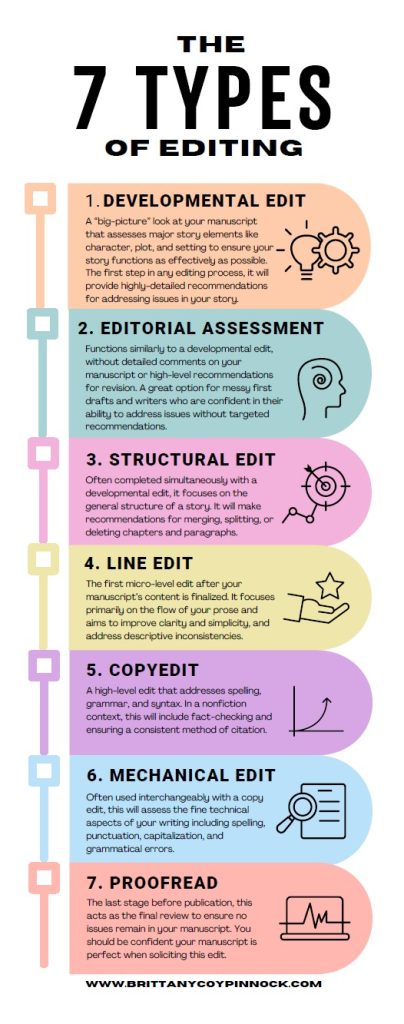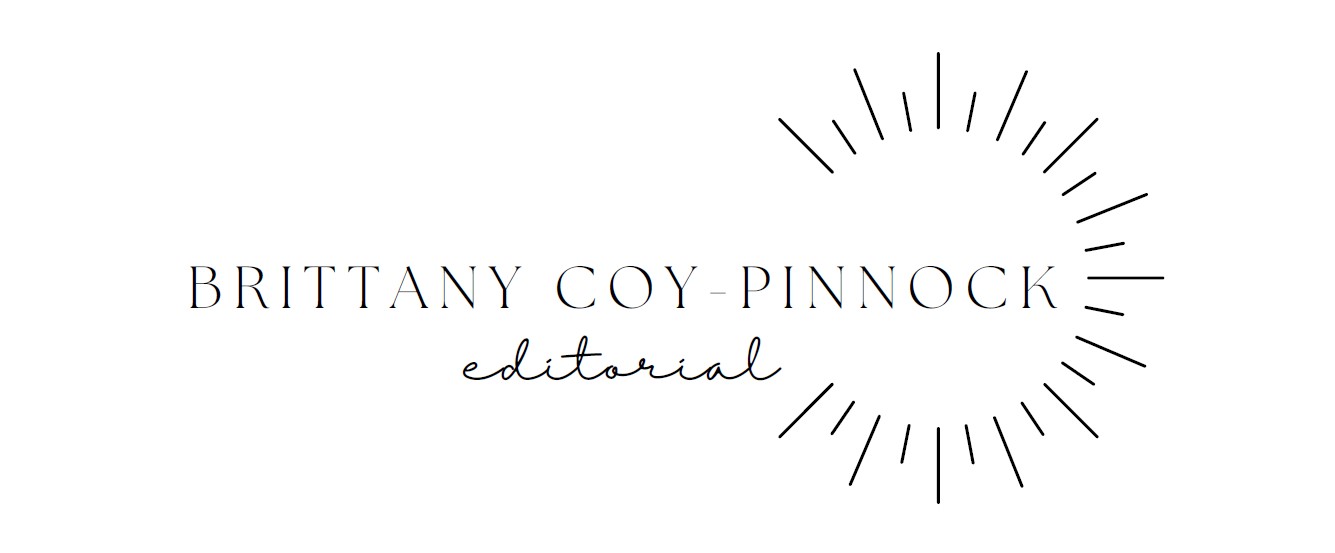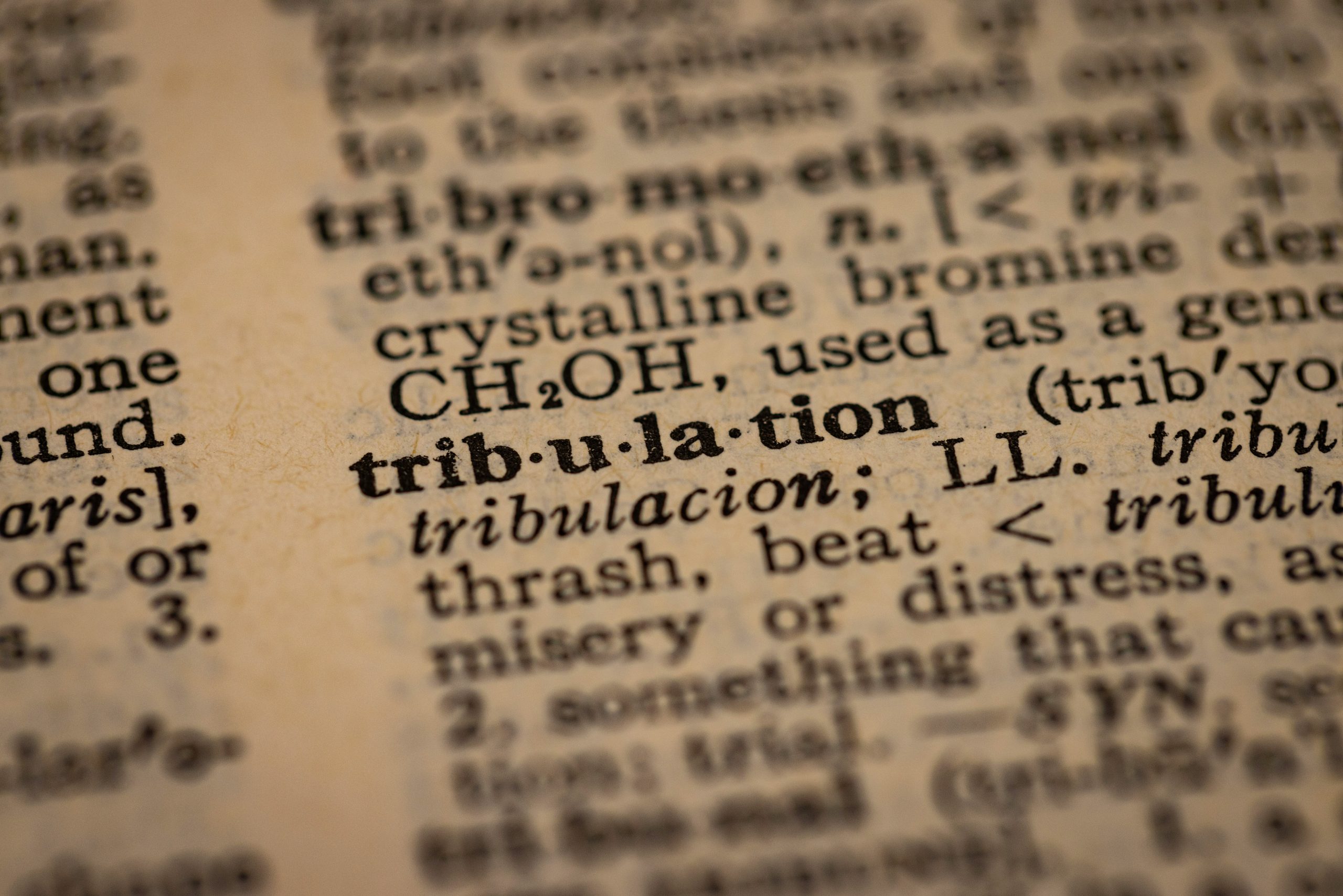7 Types of Editing and How To Decide Which One You Need
Your manuscript will go through many phases of editing, and there’s a good chance you’ll be sick of it by the time you’re done. For this reason—and several others—it’s a good idea to hire a freelance editor at various stages of the process. To even begin to decide which editor to choose, you first have to understand the 7 types of editing available, and at which point of the process you’ll need them.
If you’re short on time, check out this handy infographic! Otherwise, read on for a detailed explanation.

1. Developmental Edit
The most general option is a developmental edit, also known as a substantive, or content edit. This foundational edit takes a big picture look at your manuscript, and will assess story elements like character, setting, plot, and stakes. A good developmental editor will also check for secondary elements like tension, momentum, pacing, and point of view. They’ll evaluate your characters to determine if they’re as developed as they could be and assess your plot for weak points and discrepancies.
A developmental editor’s goal is to gauge if your story functions as effectively as it can, and if not, offer recommendations for improvement. This edit is highly transformative by nature, and there will be big changes. Entire sections may be deleted, and entire chapters rewritten. Its transformative nature will render micro-level edits irrelevant, so it should always be your starting point. In fact, a full-length manuscript may need several developmental edits to get the building blocks just right before diving into the finer components.
What should you expect from a developmental edit?
A developmental edit should leave you with two things:
- An editorial report, or overview letter: This is a general critique of your work that will usually focus on overarching problems, or issues in the story that repeat often. They will give you a summary of what’s working well and what can be improved as well as recommendations for improvements.
- Annotated manuscript: Depending on your editor’s preferences, these can be handwritten comments in the margins of your manuscript, or they can be comments added to a word document or PDF. In either case, they will point out specific areas in your manuscript where the editor made the observations they summarize in your editorial report.
Who should get a developmental edit?
Everyone! Literally. Even if you do it yourself, everything you write should go through some form of a developmental edit to ensure every section functions as effectively as it could.
Beginner and first-time writers may especially benefit from working with an editor who will have a high-level knowledge of writing craft principles and what publishers and agents want to see in a manuscript. Even one round with a developmental editor will draw your attention to blind spots and bad habits in your writing which will help you to identify those things in your future projects.
When do you need a developmental edit?
A developmental edit should be the first step after you’ve completed the first draft of any piece of writing. In a nonfiction context, this will be the step where you assess how effectively your arguments support your thesis and if they’re organized coherently. If you’re ever in doubt about the content of your piece, it’s a safe bet that you’re in need of a developmental edit.
Depending on how long your project is, you may need several rounds of developmental edits before you can move on to the next step. This is also a good option if you’ve sent your manuscript out to several publishers and agents without hearing anything back. A developmental editor can help assess if the story is doing what you think it should be doing.
2. Editorial Assessment
An editorial assessment is essentially a developmental edit without the annotated manuscript. It will address many of the same things as a developmental edit, however there will be no comments pointing out specific passages in your manuscript. The broad-strokes nature of this edit will yield fewer details, so it will be cheaper than a developmental edit.
Who should get an editorial assessment?
Editorial assessments are great for people who are working with a very rough or messy draft which will have many of the same issues repeated over and over. This type of editing may be ideal for people who have had developmental edits done in the past and can identify problems in their story once the editor references it without needing it pointed out in the manuscript itself.
Keep in mind, if you’re looking for tips on how to fix your issues, you may want to go with a full developmental edit, since an editorial assessment’s job is to point out strengths and weaknesses in a story, not necessarily to make recommendations for fixing them.
When do you need an editorial assessment?
Because an editorial assessment is just a developmental assessment without the notes in the margin, it can be helpful in any situation where you’d need a developmental assessment. This is a good option for writers who want someone to assess the content in their manuscript but may want to save on the costs.
This is also a great option for people who want to clean up their manuscript a bit before getting a full developmental edit. Experienced writers who feel comfortable implementing feedback on their own will find a lot of value in this assessment without the costs associated with having someone include comprehensive recommendations for revision.
3. Structural Edit
Many editors use structural and developmental edits interchangeably. Others acknowledge that they are different but will complete both at the same time. As the name suggests, a structural edit will assess the general structure of a story.
A structural editor will focus on the logical flow of the story, and whether it happens in a way that will keep readers engaged. They will recommend merging chapters, splitting them, reordering them, or deleting them all together. They address paragraphs in the same way, making recommendations to tighten up your writing in some places and expand in others.
This is still a macro-level edit, so while they may address issues with style, tone, and general writing quality, you shouldn’t expect a structural editor to make recommendations concerning grammar and punctuation.
Because many developmental editors will address your story’s structure in their assessment, you generally won’t need a structural edit unless you have specific concerns about your story’s structure.
Who should get a structural edit?
Structural edits are great for academic writing, or any other more formal type of non-fiction. These are projects that require a cohesive flow that may not be as obvious as a fiction story with relatively predictable beginning, middle, and end points.
When do you need a structural edit?
Structural edits may be helpful if you feel confident about the content of your story but not the logical order in which it occurs. It’s also helpful for nonfiction writers because the clarity of their work is highly dependent on a logical flow.
4. Line Edit
The first of the micro-level edits, a line edit will focus primarily on the flow of your prose. It’s meant to assess if your writing conveys your story in the best way possible. Your line editor will consider elements like word choice, diction, style, and voice to ensure readers enjoy a smooth reading experience.
They will address tense changes, point out clichés or run-on sentences, and recommend fixes for awkward narrative, clunky dialogue, or illogical organization. Your line editor’s goal will be to polish your writing for clarity and simplicity, and smooth out any descriptive inconsistencies.
What should you expect from a line edit?
At the very least, a line editor will return your manuscript to you with tracked changes so that you can decide which of their corrections you want to implement and which to disregard. Some line editors may include comments or an overview letter if they are correcting the same types of mistakes over and over, however this is not necessary for a good line edit.
Who should get a line edit?
Similar to a developmental edit, a line edit is one that everything you write should go through, even if you do it yourself. The objective is to make sure everything in your prose is said as eloquently as possible in order to minimize moments where the reader is pulled from your story because of inconsistencies or confusion.
When do you need a line edit?
A line edit should be your first step after the content of your manuscript is finalized to your liking. It will be helpful if you notice excess “fluff” in your story or pacing issues that a developmental edit doesn’t resolve. Line edits will also be of great value if you find yourself struggling to meet a word count.
5. Copyedit
This type of edit will address fine issue in your prose including spelling and grammar, syntax, word usage and repetition, and consistency in your style and tone. A large component of copy editing is to distinguish grammatical correctness from your audience’s needs. For example, many writing craft books tell you to kill all adjectives, which is generally sound advice, but pick up any novel off any bookstore shelf and open it to any page, and I guarantee you’ll find an adjective. Your copyeditor will help you decide which adjectives need to die and which improve your work.
A copyeditor will assess if the tone and style you’ve chosen is appropriate for your target audience and will point out where jargon or verbosity make your writing inaccessible for that audience. They will also do fact-checking, checking for defamation, and if applicable, will ensure you’re using the correct style guides for citations, be that MLA, APA, or something else.
When do you need a copyedit?
A copyedit comes after all the content and phrasing issues in your manuscript have been addressed. It should be your go-to if you’re getting a lot of feedback about grammar or clarity issues in your manuscript.
6. Mechanical Edit
Often used interchangeably with a copy edit, a mechanical edit is one which looks at the technical aspects of your writing. It will address spelling and grammar errors, punctuation, formatting, and consistency in your capitalization, abbreviations, and punctuations.
When do you need a mechanical edit?
A mechanical edit functions in the same space as a copyedit, so you won’t necessarily need both. This edit addresses the nitty gritty grammar and punctuation issues in your piece. If you don’t need any fact-checking or assessments of citations, this edit can save you money compared to a copyedit.
7. Proofread
A proofread is the final stage before publication and it’s highly recommended that it be done by a third-party editor who hasn’t seen your manuscript before this point. If opting to do this phase on your own, it’s a good idea to give yourself as much time as possible after the previous edit, so the work is fresh when you get to it. Failing these two, it’s a good idea to read your work out loud or use the read aloud feature if your word processing software has one.
This type of edit will check for minor spelling mistakes and formatting errors and will make sure there are no inconsistencies in the spelling and style or in the layout and typography. It will fix any awkward page breaks or confusing line breaks, and it will fix any issues in the captioning or the page numbers in the table of contents.
Your work should be perfect, or close to perfect at the proofread stage, and it is meant to be a failsafe to catch any errors that may have been missed by previous editors. If your manuscript is littered with issues, it may be necessary to do another copy edit.
When do you need a proofread?
Everybody needs a proofread and it should be the very last thing you do before you publish your work. It’s time for a proofread when you feel confident that your piece is as close to perfect as it can be.
Conclusion
Now that you can identify the different types of editing, it will be that much easier to decide which one you need and find an editor that can provide that for your manuscript.
Related Posts
How to Find an Editor and Red Flags to Look Out For
Finding a great editor will require more luck than people realize. Here are 7 tips for how to hedge your bets, and maximize your experience with a freelance editor.




Pingback: How to Find an Editor and Red Flags to Look Out For – Brittany Coy-Pinnock